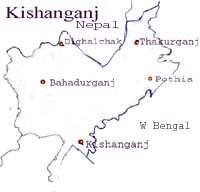
NGOs
Seminar On
Poverty
FundingAgencies
NGO'sMart
Chat
Helpline
News
MessageBoard
Links
ContactUs

|
|
|
Bihar Times
News
5 lakh children suffering from night blindness in Bihar
Over five lakh children are suffering from night blindness in Bihar. According to World Health Organisation (WHO) report, vitamin A deficiency is the world's leading cause of preventable blindness and also a major contributor to the high death rates in infants and young children in malnourished communities. A survey carried out by the Indian Council for Medical Research (ICMR) in 1997-98, found the prevalence of Vitamin A Deficiency (VAD) in Bihar to be five times higher than the accepted norms for the country.
Elimination of VAD is now considered an integral element of maternal and child survival programmes. A two-pronged strategy was being adopted throughout the country for elimination of blindness due to Vitamin A deficiency.
A short-term strategy involved administering megadoses of Vitamin A, five times at intervals of six months to children in the age group of nine months to five years.
The Netra Jyoti programme is a six-monthly campaign for children of nine months to five years, with a total of five doses of vitamin A to be given at an intervals of six months.
The long-term strategy involved dietary improvements by promoting the production and consumption of locally available inexpensive vitamin rich foods, especially by pregnant and lactating mothers and children below five years of age.
On March 18 this year, on the occasion of Netra Jyoti Diwas, more than 1.35 crore children were administered concentrated dose supplement of vitamin A. To facilitate the state-wide programme, the Bihar government in collaboration with the UNICEF had set up 61,350 booths in 37 districts manned by 1.22 lakh health workers. In Patna district alone, 3210 Vitamin A centres were set up including 840 in the state capital. 28 flood prone districts were already covered in the first phase on August 13 last year under the Netra Jyoti programme.
|
|
Bihar govt officially bans child labour

Patna: The Bihar government has now officially banned child labour. A decision to this effect has been taken by the state cabinet. It forbids government employees to employ children below the age of 14.
Earlier, the Personnel and Administrative Reforms
department had suggested ban on employing children below the age of 14.
|
NABARD to spend Rs 4.67 cr on tea plantation

The National Bank for Agriculture and Rural Development (NABARD) has decided to spend Rs 4.67 crore in Bihar through the State Bank of India (SBI) on tea plantation in the state. The scheme, falling under the Area Development Project (ADP), envisages tea plantation on 1,200 acres of land in Kishanganj district.
Since Kishanganj is situated on the border of West Bengal and Nepal, the quality of its soil and its climatic condition has been found almost similar to those of tea-growing areas of West Bengal and Nepal. Hence it is suitable for tea plantation.
The tea board has identified five blocks in the district, including Kishanganj, Thakurganj, Pothia, Bahadurganj and Dighalchak, as suitable areas for tea cultivation. The board also declared these blocks as non-traditional areas for tea plantation and agreed to extend the facilities and financial assistance under its New Area Development Programme (NADP). Almost 4,000 hectares of land in the aforementioned blocks of the district has been proposed to be brought under the tea plantation. Another 2,000 hectares of land would be brought under tea plantation during the current financial year, with banking support.
The move is expected to provide scope for large scale area expansion and create necessary infrastructures like adequate extension service, trained labour and tea processing factory. It
will give a boost to the local economy and help the state generate more money.
National policy for women
The year 2001 would be the 'Women's empowerment year' and the Cabinet has approved the 'National policy for the empowerment of women'. The policy aims to bring about advancement, development and the empowerment of women. Under the policy, national and state-level councils will be set up to oversee the operationalisation of the policy on a regular basis.
The national council will be headed by the Prime Minister and the state councils by the respective chief ministers of the states. A time-bound action plan will be drawn up by the ministries and departments.
It has announced a series of plans and programmes, including the Integrated Women's
Development Programme (IWDP) for the empowerment and enrichment of women. Several laws governing women are going to be suitably amended in order to make them more effective. These include the Indecent and Obscene Representation of Women Act, Child Marriage Act, Commission of Sati Act, and Prevention of Immoral Traffic Act. A new law governing domestic violence is going to be enacted soon.
| |
The tallest monument of the World at Bodh Gaya

The 500-ft / 152.4-metre bronze statue of Maitreya Buddha is being designed to last for at least 1,000 years - through our new millennium and into the next. The statue is scheduled for completion in January, 2005.
Situated in forty
acres of magnificently landscaped park, it will be a public contribution of timeless beauty,
combining traditional art with modern engineering and technology. It is a unique effort to combine
both the spiritual and practical needs of all who will view it: those who live and work in Bodhgaya, as
well as those who will visit in their search for inspiration and rejuvenation of body and mind.
Never before has a statue of this size been constructed. The Maitreya Statue will be a feat of modern engineering and the architectural, constructional and maintenance challenges posed by the Project require the very latest skills in a variety
of technologies. The huge structure must withstand high
winds, extreme temperature changes, seasonal rains,
possible earthquakes and floods, and environmental pollution
throughout at least 1,000 years.
Combining medical, educational and spiritual public facilities with magnificent, inspirational
architecture and art, the Project will create an example of socially responsible development that is
environmentally sustainable and built to last 1,000 years.
These facilities will complement and help to sustain India's existing pilgrimage sites. The Project
will catalyze a gradual development of the area's infrastructure, including the renovation and
development of Bodh Gaya's airport and tourism facilities. In this way, the most holy of Buddhist
sites will become more easily accessible to the world's Buddhists, and to the many others, who will
want to come to Bodh Gaya to experience its holy atmosphere and visit its historic sites; to learn,
explore and enjoy. The Maitreya Project will provide new opportunities, for visitors and local
residents alike, to experience what the Buddha taught through pilgrimage, meditation, devotion and
service to others.
More about the Project...

More...
Back
|
|



